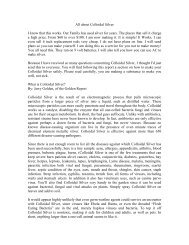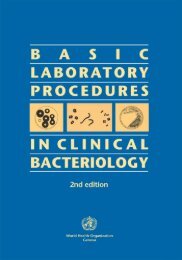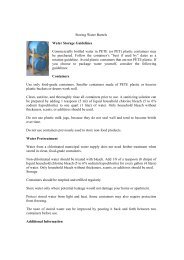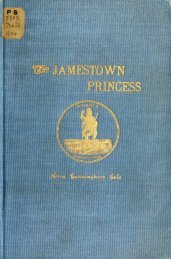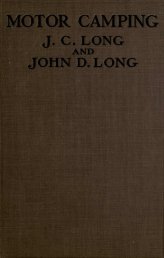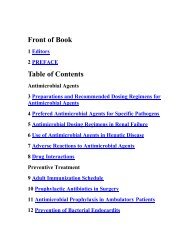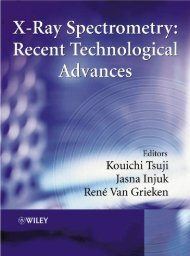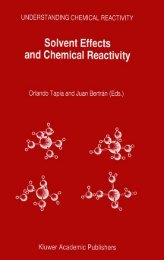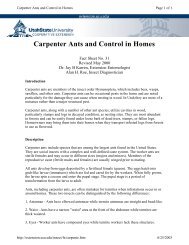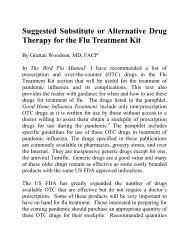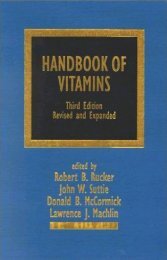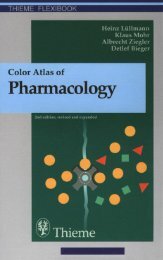The Nutritional Biochemistry of Chromium(III) - Survival-training.info
The Nutritional Biochemistry of Chromium(III) - Survival-training.info
The Nutritional Biochemistry of Chromium(III) - Survival-training.info
Create successful ePaper yourself
Turn your PDF publications into a flip-book with our unique Google optimized e-Paper software.
Introduction: A history <strong>of</strong> chromium studies (1955–1995) 7Another attempt to identify “GTF” from Brewer’s yeast separated 11 apparentlyhomogeneous Cr-containing species from the yeast [23]. <strong>The</strong> species were amphoteric,anionic, and cationic. <strong>The</strong> four cationic species and one anionic species displayed someability to stimulate yeast fermentation. Further investigation [33], however, revealedthat all 11 species were artifacts formed between components <strong>of</strong> the growth media andchromic ions added to the media. <strong>The</strong> authors proposed that “GTF” could no longer beregarded as a chromium complex.Holdsworth, Neville, and coworkers have examined Brewer’s yeast extracts extensively[34–37]. <strong>The</strong>y too have been able to distinguish between Cr-containing fractions(either cationic or anionic) and a fraction active in in vitro biological activity assaysusing rat adipocytes; rat hepatocytes from control rats, Cr-deficient rats, and rats onCr-deficient diets supplemented with chromium and yeast. <strong>The</strong>y conclude that theenhanced response in the presence <strong>of</strong> insulin comes from gamma-aminobutyric acid inthe yeast extracts. No evidence was found that “GTF” aided the binding <strong>of</strong> insulin-toinsulinreceptor, such as by the formation <strong>of</strong> a ternary complex. <strong>The</strong> “GTF”-like activityfrom non-Cr-containing fractions using the adipocyte assay required the cells to be fromrats on a Torula yeast diet.Most recently, Hwang and coworkers [38] and also Simon<strong>of</strong>f et al. [39] showedthat the fractions <strong>of</strong> Brewer’s yeast that stimulate glucose oxidation by rat adipocytes inthe presence <strong>of</strong> insulin were distinct from the fractions containing chromium. <strong>The</strong> ratswere raised on a standard (i.e., Cradequate) diet.Biological activity assaysUntil this point in time, biological activity <strong>of</strong> a chromium-containing speciesreferred to the ability <strong>of</strong> the species to potentiate the action <strong>of</strong> insulin to stimulate in vitrothe metabolism <strong>of</strong> epididymal fat tissue from “chromium-deficient” rats. “<strong>Chromium</strong>deficient”rats in this definition means rats on the Torula yeast diet or another dietgiving rise to similar effects when rats are given glucose tolerance tests (which, asdiscussed earlier, have essentially no data supporting their actually being chromiumdeficient). <strong>The</strong> reproducibility and sensitivity <strong>of</strong> the assay for biological activity wasimproved in 1978 by Anderson and coworkers who showed that adipocytes isolatedfrom epididymal fat tissue <strong>of</strong> “Cr-deficient” rats could be utilized [40]. Replicate assaysat a series <strong>of</strong> insulin concentrations could now be readily performed, allowing fordetailed kinetics experiments. <strong>The</strong>se assays showed that Brewer’s yeast extracts andthe synthetic Cr–nicotinate complexes described above potentiated the ability <strong>of</strong> insulinto stimulate glucose oxidation at a variety <strong>of</strong> insulin concentrations. <strong>The</strong> degree <strong>of</strong>stimulation also depended on the chromium concentrations <strong>of</strong> either the extract orsynthetic complexes, leading to the conclusion that these compounds contain biologicallyactive forms <strong>of</strong> chromium. However, further analysis <strong>of</strong> these results has shown thatthe original interpretation is incorrect [41]. Addition <strong>of</strong> the chromium sources withoutadding insulin stimulated the metabolism <strong>of</strong> glucose; the stimulation due to insulin abovethis increased background was actually decreased. <strong>The</strong> chromium sources in fact madeinsulin less effective, consistent with components <strong>of</strong> the extracts binding to insulin (asdescribed above) and not allowing the complexed insulin to bind to its receptor. Analternative has been pointed out in that the isolated adipocytes may not have been washedsufficiently to remove traces <strong>of</strong> insulin [42]; however, extrapolation <strong>of</strong> the insulin dose



